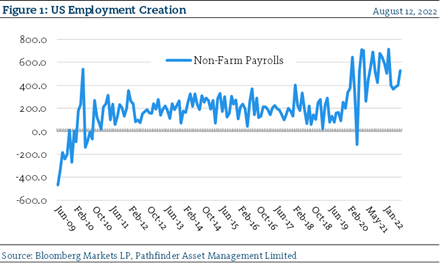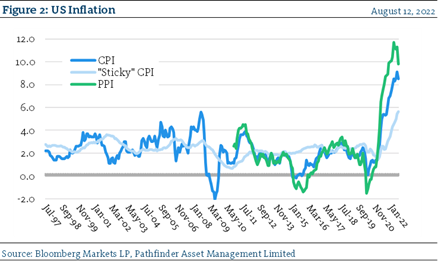Fresh data telling a story
We digress from our recent study on the aggregate change in financial asset market value to focus on a few interesting data points that came out of the US over the past couple of weeks. Stock markets have been on a bit of a tear recently and the fixed income markets have been quite volatile as well (i.e. US tech stocks up +20% into a new “bull market”, while the US Treasury 2-10 yield curves have further inverted). The data points below have contributed to changing investor expectations. We believe that this is the reason for most of the recent volatility.
- In Figure 1, we present US Non-Farm Payrolls, with the pandemic period removed. This forms the main data in the monthly “Jobs” This past month, just over half a million jobs were created, which was twice the number the market expected, and ultimately was viewed very favorably. More jobs implies a healthy economy, and at the margin, eventually lower wage pressure, which is good for inflation pressure over time.

- In Figure 2, we present various inflation data points. The CPI print last week caused significant market reaction, with investors now betting the FOMC will become more dovish in the coming months. They view that the CPI may have peaked, which is what has driven the bullish reaction. However, we did read an interesting article about how the FOMC focuses on “Sticky Inflation” (light blue line) as produced by the Atlanta Fed. This data shows stable prices are still increasing, so there is real potential the market has overreacted to the headline CPI number.

- The green line is the Producer Price Index (PPI) and it measures input prices “at the factory gate”. If those prices are rising, then that usually ultimately translates to higher consumer prices. Much like the CPI data, it looks like those prices may have peaked as well.
“This means that” while the data looks good, we believe the read through on the market is too optimistic. A number of our mandates have taken short positions to balance the risk, while others have focused on ignored parts of the market. We expect this is a medium-term issue not easily solved. As a result, we should see more volatility ahead.
National Instrument 31-103 requires registered firms to disclose information that a reasonable investor would expect to know, including any material conflicts with the firm or its representatives. Doug Johnson and/or Pathfinder Asset Management Limited are an insider of companies periodically mentioned in this report. Please visit www.paml.ca for full disclosures.
*All returns are time weighted and net of investment management fees. Returns from the Pathfinder Partners’ Fund and Partners’ Real Return Plus Fund are presented based on the masters series of each fund. The Pathfinder Core: Equity Portfolio and The Pathfinder Core: High Income Portfolio are live accounts. These are actual accounts owned by the Pathfinder Chairman (Equity) and client (High Income) which contain no legacy positions, cash flows or other Pathfinder investment mandates or products. Monthly inception dates for each fund and portfolio are as follows: Pathfinder Core: Equity Portfolio (January 2011), Pathfinder Core: High Income Portfolio (October 2012) Partners’ Fund (April 2011), Partners’ Real Return Plus Fund (April, 2013), and Partners’ Core Plus Fund (November 2014).
Pathfinder Asset Management Limited (PAML) and its affiliates may collectively beneficially own in excess of 10% of one or more classes of the issued and outstanding equity securities mentioned in this newsletter. This publication is intended only to convey information. It is not to be construed as an investment guide or as an offer or solicitation of an offer to buy or sell any of the securities mentioned in it. The author has taken all usual and reasonable precautions to determine that the information contained in this publication has been obtained from sources believed to be reliable and that the procedures used to summarize and analyze such information are based on approved practices and principles in the investment industry. However, the market forces underlying investment value are subject to sudden and dramatic changes and data availability varies from one moment to the next. Consequently, neither the author nor PAML can make any warranty as to the accuracy or completeness of information, analysis or views contained in this publication or their usefulness or suitability in any particular circumstance. You should not undertake any investment or portfolio assessment or other transaction on the basis of this publication, but should first consult your portfolio manager, who can assess all relevant particulars of any proposed investment or transaction. PAML and the author accept no liability of any kind whatsoever or any damages or losses incurred by you as a result of reliance upon or use of this publication.